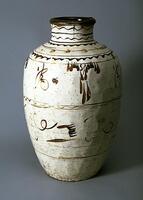30 UMMA Objects
30 UMMA Objects
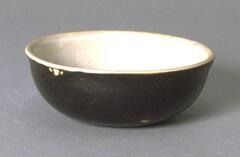
Chinese (Chinese (culture or style))
Jar Cover
800 – 999
Given in memory of James Marshall Plumer by John Maxon, Architecture and Design '41
1961/2.1
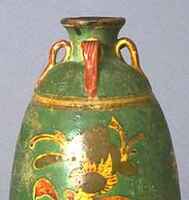
Chinese (Chinese (culture or style))
Bottle
1271 – 1368
Museum purchase for the Paul Leroy Grigaut Memorial Collection
1969/2.152
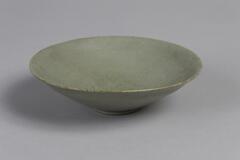
Korean (Korean (culture or style))
Celadon Bowl
Gift of Margaret Condon Taylor in honor of Professor Kim Young Sook
2014/2.106

Iranian (Iranian)
Shallow open box with three compartments, adorned with women's faces
19th century
Museum Purchase
1957/1.99

Annam;Kiln Unknown, Vietnam
Beaker with mottled green drip glaze
16th century
Gift of Helmut Stern
1991/1.96
![<p>This type of celadon was produced in large quantities during the 13th century when celadon with inlaid designs became more decorative. The upper part of the inner wall features a band of scroll design inlaid with white slip close to the rim, below which are four double concentric circles each containing a peony spray inlaid with black and white slip. Glaze was applied down to the rim of the foot. Three quartzite spur marks remain on the outer base. The entire inner surface features ne crazing. Two horizontal bands inlaid with white slip surround the upper part of the outer surface. The glaze was partially oxidized, tinged with brown.<br />
[<em>Korean Collection, University of Michigan Museum of Art </em>(2014) p.105]</p>
Shallow bowl with celadon glaze. Four peony designs encapsulated by a double-ringed circle float equally spaced along the inner curve of the bowl. A wavy fret design marks the inner rim, while the outer is marked by two or three incised lines. <p>This type of celadon was produced in large quantities during the 13th century when celadon with inlaid designs became more decorative. The upper part of the inner wall features a band of scroll design inlaid with white slip close to the rim, below which are four double concentric circles each containing a peony spray inlaid with black and white slip. Glaze was applied down to the rim of the foot. Three quartzite spur marks remain on the outer base. The entire inner surface features ne crazing. Two horizontal bands inlaid with white slip surround the upper part of the outer surface. The glaze was partially oxidized, tinged with brown.<br />
[<em>Korean Collection, University of Michigan Museum of Art </em>(2014) p.105]</p>
Shallow bowl with celadon glaze. Four peony designs encapsulated by a double-ringed circle float equally spaced along the inner curve of the bowl. A wavy fret design marks the inner rim, while the outer is marked by two or three incised lines.](/media/W1siZiIsIjIwMjIvMDkvMjQvMXg2MXpyYmRncl9kZWZhdWx0LmpwZyJdLFsicCIsInRodW1iIiwiMjQweDIwMCJdXQ?sha=0da4d5351d2ae02c)
Korean (Korean (culture or style))
Shallow Bowl with Peony Design
13th century
Gift of Bruce and Inta Hasenkamp and Museum purchase made possible by Elder and Mrs. Sang-Yong Nam
2004/1.233

Duncan Hartley
Art Class, from "Classmates of Class of 1960"
1958 – 2013
Gift of the artist
2013/2.3
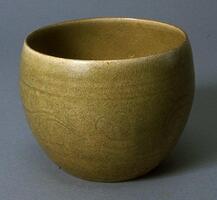
Annam;Kiln Unknown, Vietnam
Beaker with incised leaf scroll pattern
16th century
Gift of Helmut Stern
1991/1.95
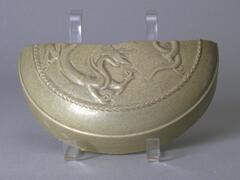
Chinese (Chinese (culture or style))
Fragment of box lid
10th century
Gift of Mrs. Caroline I. Plumer for the James Marshall Plumer Collection
1964/2.3
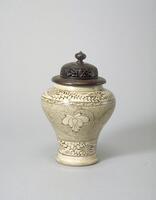
Chinese (Chinese (culture or style))
Jar
1271 – 1368
Transfer from the College of Architecture and Design
1972/2.65A&B
Loading…

